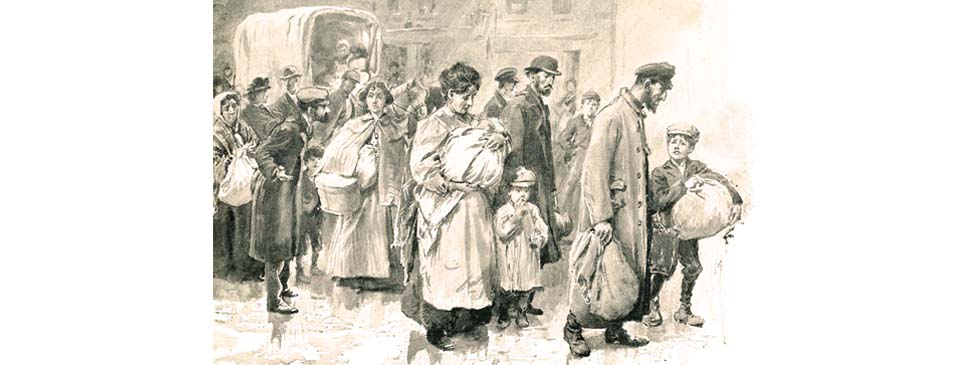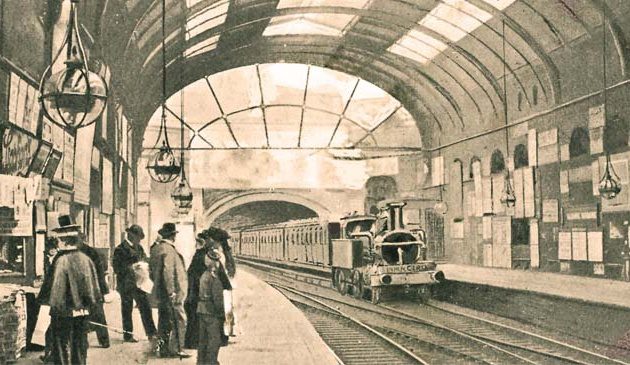London’s Jewish Community in the 19th century. Part 1 – Their arrival

Thousands of poor Ashkenazi Jews from Russia and Poland arrived in London in the last thirty years of the 19th century and first few years of the 20th century.
Those leaving Eastern Europe were generally under no illusion as to what to expect of their new homeland, from letters received from those who had already settled here. The view of England was of a generally free country, where they would enjoy civil and political rights. On the other hand, they would be separate from the indigenous population and mostly disliked, with a great deal of anti-Semitism amongst the English working-class. They were normally aware before they set off that it would be necessary to work extremely hard for little reward but at least with the possibility of making one’s fortune. Whatever the disadvantages, it was better than the oppression and poverty they were leaving behind.
Even during the first half of the 19th century immigrants were obliged to take a Christian sacrament to become a naturalized Briton. Many Jews simply hid their ethnicity. Catholics in Britain largely gained emancipation in 1829, freeing them from previous social and legal restrictions. It was hoped the same would happen for Jews but it was a slow and gradual process that came in small steps. A major obstacle for those wishing to take up a political position was the Oath of Office, which included loyalty to the Church of England, originally an anti-Catholic device. (Benjamin Disraeli was born a Jew but converted to Anglicanism and was thus able to become an MP and Prime Minister). In 1847 Lionel de Rothschild was elected as MP for the City of London, followed in 1851 by David Salomons for Greenwich, but neither were able to take their seat in Parliament due to that barrier. Following a change in the law, Salomons was elected as Mayor of London in 1855. The Jews Relief Act of 1858 finally opened the doors of Parliament to Jews and Rothschild was then able to sit in the Commons.
By the middle of the 19th century there were already such large numbers of poor Jews in London, many not associated with a synagogue, that community charity became inadequate. Providing handouts by the City synagogues was also controversial and led to chronic beggary. A group of young Jews founded the Board of Guardians for the Relief of the Jewish Poor in 1859. It initially supported only those not associated with a synagogue but within a few years was distributing most of the charitable Jewish funds in London. Names associated with this charity include bankers and wholesale merchants, such as Rothschild, Montefiore and Goldsmid.
Some of the worst enemies of the Russian arrivals were the already-assimilated Jews who saw the newcomers as a challenge to their prosperous social order and risking an upsurge in anti-Semitism. The arrivals dismayed the established Jewish elite and the Board of Guardians. Wherever possible the Board discouraged others from emigrating from Russia, or encouraged them to travel on to America instead. There was a great difference of opinion between the new East European immigrants and previously-settled Jews, whereby the former generally desired to keep their old customs and mostly remain separate from the native population. The latter wanted the new arrivals to Anglicize, replace Yiddish with English, assimilate, and move away from the East End ghetto.
To discourage newcomers, the Board of Guardians required at least six months residence before providing assistance. On the other hand, influential voices, such as Sir Samuel Montagu, were more sympathetic to giving immediate aid and comfort. Simon Cohen opened the Poor Jews’ Temporary Shelter at Church Lane in Whitechapel in 1885 but the Board of Guardians had it closed down on sanitary grounds. Montagu and others took it over and provided a building in Leman Street to give a home for new arrivals for up to two weeks. It eventually sheltered up to 4,000 immigrants each year.
The annual flow of Jewish emigrants out of Russia settled down during the 1890s, with around 3,000 arriving each year, but the numbers rose again in the first years of the 20th century. The causes were: an exodus of several thousand Jews from Romania in 1899-1900 in protest against oppression; rioting by mobs who killed Jews and destroyed their property at Kishinev in Moldova in 1903; the pogroms that followed the first Russian revolution of 1905; and to avoid military service in Siberia during the Russo-Japanese war of 1905-1906. Those were significant events, but continuous issues were the lack of work, unpredictable harvests, and general anti-Semitism. The largest number of Jewish immigrants arriving in England occurred between 1905 and 1906.
Sources include: Lloyd P.Gartner ‘The Jewish Immigrant in England 1870-1914’; ‘Living London’ ed. George R. Sims (1902); Robert Winder ‘Bloody Foreigners’; Panikos Panayi ‘Migrant City’; John Marriott ‘Beyond the Tower’; Sir Hubert Llewellyn Smith ‘The History of East London’ (1939).
Forward to London’s Jewish Community in the 19th century. Part 2 – Their lives >


